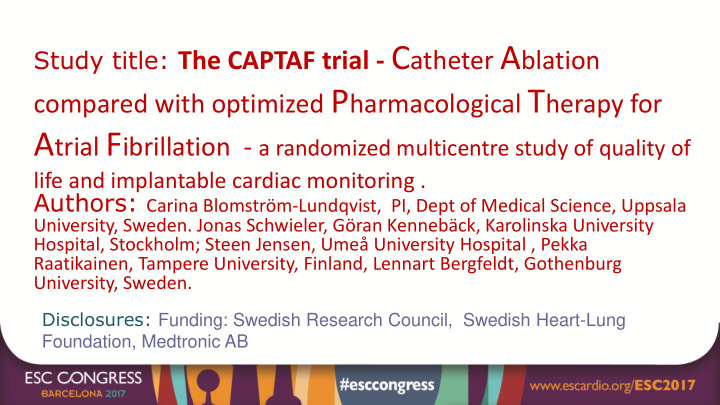



Study title: The CAPTAF trial - C atheter A blation compared with optimized P harmacological T herapy for A trial F ibrillation - a randomized multicentre study of quality of life and implantable cardiac monitoring . Authors: Carina Blomström-Lundqvist, PI, Dept of Medical Science, Uppsala University, Sweden. Jonas Schwieler, Göran Kennebäck, Karolinska University Hospital, Stockholm; Steen Jensen, Umeå University Hospital , Pekka Raatikainen, Tampere University, Finland, Lennart Bergfeldt, Gothenburg University, Sweden. Disclosures: Funding: Swedish Research Council, Swedish Heart-Lung Foundation, Medtronic AB
Background • Previous randomized trials report that pulmonary vein isolation is more effective in preventing atrial fibrillation (AF) than antiarrhythmic drugs, but effects on AF burden is unclear as no trial used continuous cardiac rhythm monitoring (ICM, implantable cardiac monitor). • Up-to-date no AF ablation trial used Quality of Life (QoL) as primary end- point even though main indication for AF ablation is symptom relief. – Instead, 30 sec AF recurrences used as primary endpoint – hardly a relevant measure of successful therapy. The purpose was therefore to clarify these issues by using QoL as primary end-point and ICM to assess treatment effects on AF burden
Declaration of Interest Funding: • Swedish Research Council, • Swedish Heart-Lung Foundation, • Medtronic AB
K ey points about methods • Prospective, randomized, multicenter, and controlled trial including patients with symptomatic paroxysmal or persistent AF who failed at most 1 antiarrhythmic drug or a beta-blocker. • An implantable cardiac monitor (ICM) implanted before randomisation to assess AF burden. Effects on QoL as primary endpoint, symptoms and AF burden assessed by ICM and compared between the two randomized treatment strategies, pulmonary vein isolation or antiarrhythmic drugs. Ablation Run-in Incl. 3, 6 9 12 ………..…. 48 mo ICM R FU: 2 mo Drug
Results • QoL with general helath as primarfy endpoint and symptoms improved significantly more with ablation than with drugs at 12 months. • There was no difference in magnitude of reduced AF burden between treatment groups at 12 months follow up. AF burden (% of time) over time Month 12 100 30 Ablation Drug 80 25 Mean AF burden (% of time) Mean score 20 60 15 40 10 12 months 20 5 Ablation Drug Swedish Norm 0 0 GH PF MH BP RE RP SF VT 0 3 6 9 12 SF-36 Quality of life at 12 months Month
Conclusions • Using QoL as primary end-point we demonstrated that pulmonary vein isolation is significantly more effective than antiarrhythmic drugs in a mixed population of paroxysmal and persistent AF patients, even at an early stage of their disease. • Reduction in AF burden (ICM) was numerically larger in the ablation than in the antiarrhythmic drug group but the change from baseline did not reach statistical significance between treatment groups. • Other mechanisms than effects on AF burden may explain the better improvement of QoL and symptoms with ablation than with drugs. • Complication rates between treatment groups comparable
Recommend
More recommend